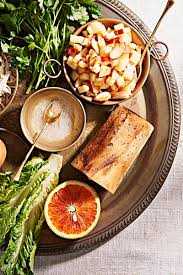Watch
Events
Articles
Market
More
Shalom Aleikhem, Nashim,
As we approach Moed h'Pesah (the appointed feast of Passover), let us selah (pause, meditate) on the spiritual implications and significance of this season.
As Keepers of the Covenants of Israel, Women of the Covenants have a most serious responsibility to be faithful to learn and to do our portion of all that's written within the content/context of Torah. In Wayyikra 23:5 HaShem is speaking to the Bahnote Yisrael - the whole house of Yisrael to keep the charge of the mo'ed of Pesah. 7And they shall take of the dahm (blood), and strike it upon the two mezuzot (doorposts) and on the mashkof (lintel) of the batim (houses), wherein they shall eat it.
HasShem, in his infinite chesed, has again made The Way for his Kedoshim to be redeemed from the cruelties of Mitsrayim/Egypt upon them, and His resulting and necessary wrath.
Let's keep our fore parents in the context into which they lived. The Way was made by the blood of an innocent lamb. They had to "Shema" hear/listen and to obey what HaShem had spoken. Had they not, death would've come in the harshest way to their households. Imagine witnessing the death angel overshadowing your firstborn son or daughter and watching them die a painful death all because you chose to not listen and obey the message of HaShem via His mouth-piece, Moshe. There was more wailing, screams of terror, sickness, and the smell of death than we, in our modern, 21st Century minds can imagine! And, yes, many Israelite homes suffered the same plight as their Egyptian neighbors because of the heavy influence of the Egyptians of that time. All that was required was the blood of a spotless lamb, and to smear the blood to the lintels, denoting the openness that we're to have as Natzarim Yehudim to live out our identity as one people under HaMoshiach. It was not to be smeared on the threshold which would mean to trample it, or to devalue the preciousness of it. We were to be careful as to how we heard and obeyed the command. We were then instructed to roast it whole with fire, and to eat all of it. Again, as the Nashim of Israel we can probably assume that our mothers had a lot to do with making the lamb fit to eat for the family table. This was very hard work, and one that had to be done quickly for their exodus out of Egypt was just in a matter of time. They had to stand in support of their husbands overseeing that all of the lamb was eaten by their households, and not any of it held over until morning.
The practicalities, the halacha, hands-on approach, and its deeper spirituality to this first Pesah mitzvah is so vital to our continued survival as a priestly nation.
The whole lamb roasted, not looked upon only, but eaten completely symbolizes our need as nashim to "eat Messiah's flesh", or to become one with him in intimacy of His life, death, and resurrection. To make His sufferings as the Chosen People our sufferings. We must receive spiritual strength and nourishment from Him today, receiving Him today while it's called "Today", not putting Him off until tomorrow. We were to eat it with maror or bitter herbs, remembering our bitter days in Egypt which for us, who have been redeemed, represents the house of bondage. We're to eat it with soberness of heart as we consider Messiah's cruel and undeserved beatings, mocking, and ultimate death for us. We were told to eat it with unleavened bread/matzah. This represents the bruises and piercings of our Beloved Master. Just as the first Matzah was eaten in haste, our Moshiach could not be held by death, but was kept in the heart of the earth for the appointed time/mo'ed of His Father.
As you perform your duties as the nashim of your priestly and royal households, take very seriously the words of your Messianic Haggadot. Eat and savor each word, making them your own. As you partake of the cups, take in that it was your Messiah who instituted this practice for the households of Israel typifying His precious blood, royalty, and freedom fulfilling the Torah of Pesah. According to tradition, the Israelites were delivered from Egyptian bondage because the pious women were more righteous than the men. (Rav Awira; Babylonia Talmud Sotah 11b). And because of this ancient tradition (which dates to the Maccabean period) Yehudim women have performed the honor of lighting not only the Shabbat candles, but the festival lights as well. Do so with joy and from the heart knowing that HaShem, your Father, endorses your acts as He inspired Rav Sha'ul to teach "let no man judge you in how you keep the festivals. (Col 2:16).
From my Pesah Table to Yours,
Nava Michaels
Shabbat Chol HaMoed of Passover
Torah : Exodus 33:12-34:26
Haftarah : Ezekiel 37:1-14
Gospel : John 20
Thought for the Week:
The value of Passover for believers transcends mere ritual and symbolism. It speaks to us of the death and resurrection of the Master and the great salvation of human souls. It serves as a type and a shadow for the ultimate redemption that has been granted to us through Messiah. In every respect, it is a festival for believers.
Commentary:
Moreover, they shall take some of the blood and put it on the two doorposts and on the lintel of the houses in which they eat it. (Exodus 12:7)
Moses commanded the children of Israel to mark their homes with the blood of the Passover lambs. They were to dip hyssop into the blood and smear it on their doorposts. Although Passover was thereafter celebrated annually, the Israelite homes were never again smeared with blood from the Passover lambs. The smearing with blood was a one-time ritual. Every Passover thereafter, the blood of the Passover lambs was splashed on the altar in the Tabernacle/Temple as a remembrance of the plague of the firstborn and the blood on the doorposts of Israelite homes in Egypt.
Try to imagine the Passover in the Temple on the day the Master died. While His precious body hung dying on the cross, a short distance outside the city walls pilgrims were flooding the Temple courts, leading their lambs to slaughter. While His blood stained the stones beneath the cross, the priesthood of Israel was splashing basin after basin of Passover blood against the stones of the Temple altar. While the women wept at the foot of the cross, the Levites in the Temple courts were chanting the songs of the Hallel: Psalms 113-119. Once slaughtered, the lambs in the Temple were hung from iron hooks in crucifixion poses for skinning, and once skinned, they were bound by the hooves, hand and foot as it were, to wooden poles, to be carried from the Temple on the backs of the worshippers. Meanwhile, the Master hung in crucifixion pose from iron nails, bound hand and foot to a wooden pole.
Believers have traditionally interpreted the Passover blood on the doorway as a symbol of Messiah's blood. Consider a few of the parallels. Messiah is called our Passover Lamb. He died at Passover time. Just as the death came upon Egypt to claim the firstborns, so too all mankind is given over to death. Just as those under the protection of the Passover lamb's blood markings were protected from death, so too those who take refuge under the blood of Messiah are protected from condemnation. They are given eternal life and will overcome death in the resurrection.
What is more, Messiah's blood marked the soil of Jerusalem, the city in which the Holy Temple is located. According to Jewish tradition, Jerusalem and the Temple therein are called the "gateway to heaven." It is as if Messiah's blood was smeared upon the doorposts of heaven.
(ffoz.org)



